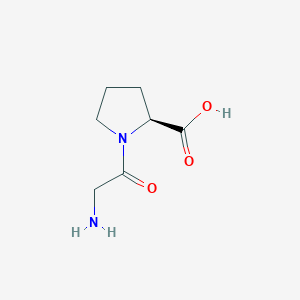| General Information of MET (ID: META00790) |
| Name |
Glycylproline
|
| Synonyms |
Click to Show/Hide Synonyms of This Metabolite
(S)-1-(2-Aminoacetyl)pyrrolidine-2-carboxylic acid; 1-(Aminoacetyl)proline; 1-Glycyl-L-proline; 1-Glycylproline; GP; GP Dipeptide; Gly-L-pro; Gly-pro; Glycine proline dipeptide; Glycine-proline dipeptide; Glycyl-L-proline; Glycyl-proline; Glycylproline; N-Glycyl-L-proline; N-Glycylproline; NSC 97929; g-p Dipeptide
|
| Source |
Endogenous;Food
|
| Structure Type |
Amino acids, peptides, and analogues (Click to Show/Hide the Complete Structure Type Hierarchy)
Organic acids and derivatives
Carboxylic acids and derivatives
Amino acids, peptides, and analogues
|
| PubChem CID |
|
| HMDB ID |
|
| Formula |
C7H12N2O3
|
| Structure |
<iframe style="width: 300px; height: 300px;" frameborder="0" src="https://embed.molview.org/v1/?mode=balls&cid=3013625"></iframe>
|
 |
|
3D MOL
|
2D MOL
|
|
Click to Show/Hide the Molecular/Functional Data (External Links/Property/Function) of This Metabolite
|
| ChEBI ID |
|
| FooDB ID |
|
| ChemSpider ID |
|
| Physicochemical Properties |
Molecular Weight |
172.18 |
Topological Polar Surface Area |
83.6 |
| XlogP |
-3.1 |
Complexity |
205 |
| Heavy Atom Count |
12 |
Rotatable Bond Count |
2 |
| Hydrogen Bond Donor Count |
2 |
Hydrogen Bond Acceptor Count |
4 |
| Function |
Glycylproline is a dipeptide composed of glycine and proline, and is an end product of collagen metabolism that is further cleaved by prolidase (EC 3.4.13.9). The resulting proline molecules are recycled into collagen or other proteins. Prolidase deficiency is a rare autosomal recessive disease characterized by chronic ulcerative dermatitis, mental retardation, frequent infections, and massive urinary excretion of iminodipeptides. Patients with this disease have reportedly decreased prolidase enzyme activity against glycylproline (Gly-Pro). The enzyme's activity against other substrates is not as affected. Some patients with prolidase deficiency have a marked urinary excretion of glycylproline. Patients with pressure sores contain significantly more urinary glycylproline than the control.
|
|
Regulatory Network
|
|
|
|
|
|
|
|
|
 click to show the details of this protein
click to show the details of this protein
 click to show the details of experiment for validating this pair
click to show the details of experiment for validating this pair

